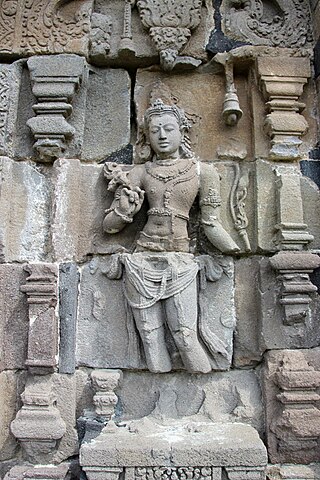
In Buddhism, a bodhisattva or bodhisatva is a person who is on the path towards bodhi ('awakening') or Buddhahood.

In Buddhism, Avalokiteśvara, also known as Avalokitasvara, is a bodhisattva who contains the compassion of all Buddhas and is the principal attendant of Amitabha Buddha on the right. He has 108 avatars, the most notable of which is Padmapāṇi. He is variably depicted, described, and portrayed as either male or female in different cultures. Guanyin is one of the female depictions of Avalokiteśvara usually seen in East Asia.

The Kanheri Caves are a group of caves and rock-cut monuments cut into a massive basalt outcrop in the forests of the Sanjay Gandhi National Park, on the former island of Salsette in the western outskirts of Mumbai, India. They contain Buddhist sculptures and relief carvings, paintings and inscriptions, dating from the 1st century CE to the 10th century CE. Kanheri comes from the Sanskrit Krishnagiri, which means black mountain.

Much Buddhist art uses depictions of the historical Buddha, Gautama Buddha, which are known as Buddharūpa in Sanskrit and Pali. These may be statues or other images such as paintings. The main figure in an image may be someone else who has obtained Buddhahood, or a boddhisattva, especially in the various traditions of Mahayana Buddhism. Other Buddhas and bodhisattvas in art have become increasingly common over the centuries, perhaps now outnumbering images of the historical Buddha.

Woljeongsa is a head temple of the Jogye Order of Korean Buddhism, located on the eastern slopes of Odaesan in Pyeongchang County, Gangwon Province, South Korea. Woljeongsa was founded in 643 by the Silla monk Jajang.

Buddhist art is visual art produced in the context of Buddhism. It includes depictions of Gautama Buddha and other Buddhas and bodhisattvas, notable Buddhist figures both historical and mythical, narrative scenes from their lives, mandalas, and physical objects associated with Buddhist practice, such as vajras, bells, stupas and Buddhist temple architecture. Buddhist art originated in the north of the Indian subcontinent, in modern India, Pakistan and Afghanistan, with the earliest survivals dating from a few centuries after the historical life of Siddhartha Gautama from the 6th to 5th century BCE.

Abhayagiri Vihāra was a major monastery site of Theravada, Mahayana and Vajrayana Buddhism that was situated in Anuradhapura, Sri Lanka. It is one of the most extensive ruins in the world and one of the most sacred Buddhist pilgrimage cities in the nation. Historically it was a great monastic center as well as a royal capital, with magnificent monasteries rising to many stories, roofed with gilt bronze or tiles of burnt clay glazed in brilliant colours. To the north of the city, encircled by great walls and containing elaborate bathing ponds, carved balustrades and moonstones, stood "Abhayagiri", one of seventeen such religious units in Anuradhapura and the largest of its five major viharas. One of the focal points of the complex is an ancient stupa, the Abhayagiri Dagaba. Surrounding the humped dagaba, Abhayagiri Vihara was a seat of the Northern Monastery, or Uttara Vihara and the original custodian of the Tooth relic in the island.
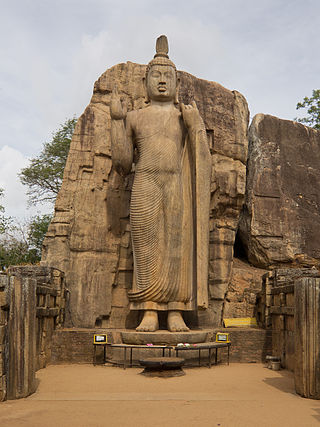
The Avukana statue is a standing statue of the Buddha near Kekirawa in North Central Sri Lanka. The statue, which has a height of more than 14 m (46 ft), depicts the Buddha with a hand raised in reassurance, a variation of the Abhaya mudra. The Avukana statue is one of the best examples of a standing statue built in Sri Lanka. It is now a popular tourist attraction.
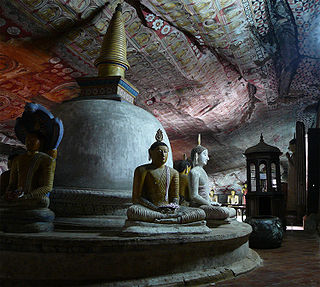
Dambulla cave temple also known as the Golden Temple of Dambulla is a World Heritage Site (1991) in Sri Lanka, situated in the central part of the country. This site is situated 148 kilometres (92 mi) east of Colombo, 72 kilometres (45 mi) north of Kandy and 43 km (27 mi) north of Matale.

The Ananda Temple, located in Bagan, Myanmar is a Buddhist temple built in 1105 AD during the reign (1084–1112/13) of King Kyansittha of the Pagan Dynasty. The temple layout is cruciform with several terraces leading to a small pagoda at the top covered by an umbrella known as hti, which is the name of the umbrella or top ornament found in almost all pagodas in Myanmar. The Buddhist temple houses four standing Buddha statues, each one facing the cardinal direction of East, North, West and South. The temple is said to be an architectural wonder in a fusion of Mon and adopted Indian style of architecture. The impressive temple has also been titled the "Westminster Abbey of Burma". The temple has close similarity to the Pathothamya temple of the 10th–11th century, and is also known as “veritable museum of stones”.
Korean Buddhist sculpture is one of the major areas of Korean art. Buddhism, a religion originating in what is now India, was transmitted to Korea via China in the late 4th century. Buddhism introduced major changes in Korean society. The complexity of the religious sutras sent to Korea required the aristocrats who adopted the religion to become literate and required the training and importation of literate scribes. Little evidence of religious art exists in Korea before the introduction of Buddhism. Subsequent to its introduction, the religion inspired the production of devotional art as well as the beginnings of sophisticated temple architecture.
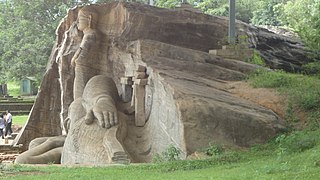
The Gal Vihara, and known originally as the Uttararama, is a rock temple of the Buddha situated in the ancient city Polonnaruwa, the capital of the ancient Kingdom of Polonnaruwa, now present-day Polonnaruwa, in North Central Province, Sri Lanka. It was fashioned in the 12th century by King Parakramabahu I. The central feature of the temple is four rock relief statues of the Buddha, which have been carved into the face of a large granite gneiss rock. The images consist of a large seated figure, another smaller seated figure inside an artificial cavern, a standing figure, and a reclining figure. These are considered to be some of the best examples of ancient Sinhalese sculpting and carving arts, and have made the Gal Vihara the most visited monument at Polonnaruwa.
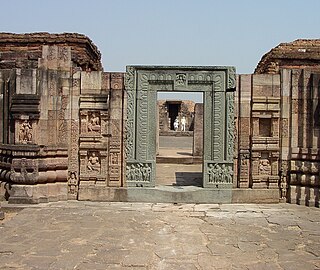
Ratnagiri is the site of a ruined mahavihara, once the major Buddhist monastery in modern Odisha, India. It is located on a hill in between the Brahmani and Birupa rivers in Jajpur district. It is close to other Buddhist sites in the area, including Lalitagiri and Udayagiri, and 100 km (62 mi) from the state capital Bhubaneswar and 70km from the former state capital Cuttack.
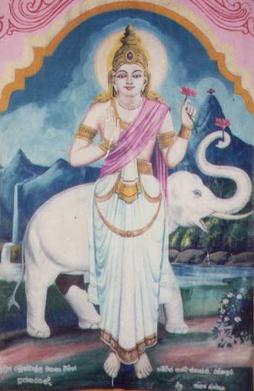
Saman is a deity, subject to local and indigenous belief and worship in Sri Lanka. The name Saman means "good minded". His character is of historical significance for the Sinhalese people and veneration especially to all the Buddhists. Maha Sumana Saman Deviraja is depicted crowned and bejeweled, holding a lotus flower in his right or left hand and accompanied by a white elephant.

The Maligawila Buddha statue is a standing figure of the Buddha in Sri Lanka, which was carved out of a large limestone rock during the 7th century by a prince named Aggabodhi who was the ruler of Ruhuna at the time. It is the tallest free-standing ancient statue of the Buddha found in the country. It had been broken into several pieces by the time it was found in 1951. The statue was reconstructed and raised again in 1980 under the direction of the then president Ranasinghe Premadasa.

The Statue of Tara is a gilt-bronze sculpture of Tara that dates from the 7th-8th century AD in Sri Lanka. Some argue it was looted from the last King of Kandy when the British annexed Kandy in the early nineteenth century, it was given to the British Museum in 1830 by the former British Governor of Ceylon, Robert Brownrigg.

Ridi Viharaya or Silver Temple is a 2nd-century BCE Theravada Buddhist temple in the village of Ridigama, Sri Lanka. Built during the reign of Dutthagamani of Anuradhapura, the temple is considered as the place where the silver ore, which provided silver to complete Ruwanwelisaya; one of the largest stupa in Sri Lanka, was discovered. According to the chronicles Mahavamsa and Thupavamsa, the Ridi Viharaya complex was built in gratitude for helping him cherish his dream of completing Ruwanwelisaya.

The Amitābha Buddha or Amitabha Buddha is an enormous Buddhist statue that was originally located in Hancui village in Hebei province, northern China. Dating to the 6th Century AD, it was given to the British Museum by the Chinese Government in 1938.
Buddhavanam is a tourism project in Nagarjuna Sagar, Telangana created by the Telangana State Tourism Development Corporation. The project was sanctioned by the Government of India viz., Integrated Development of Nagarjunasagar as part of Lower Krishna valley Buddhist circuit with a view to attract large number of domestic and foreign tourists particularly from the South-East Asian countries.

Although currently a Theravada Buddhism flourishing country, the Mahayana cult of worshipping Bodhisattva statues has existed in ancient Sri Lanka. Archaeological evidences show that Bodhisattva cult had existed as a secondary cult inferior to worship of Buddha during the Anuradhapura period. This can be assumed by the surviving Bodhisattva statues.






















